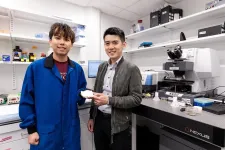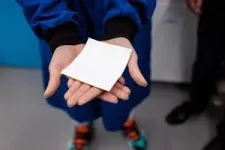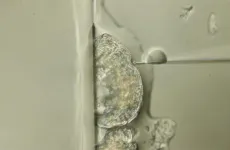(Press-News.org) This year has already seen massive heatwaves around the globe, with cities in Mexico, India, Pakistan and Oman hitting temperatures near or past 50 degrees Celsius (122 degrees Fahrenheit).
As global temperatures and urban populations rise, the world’s cities have become “urban heat islands,” with tight-packed conditions and thermal radiation emitting from pavement and skyscraper trapping and magnifying these temperatures. With 68 percent of all people predicted to live in cities by 2050, this is a growing, deadly problem.
In a paper published today in Science, researchers from the UChicago Pritzker School of Molecular Engineering (PME) detail a new wearable fabric that can help urban residents survive the worst impacts of massive heat caused by global climate change, with applications in clothing, building and car design, and food storage.
In tests under the Arizona sun, the material kept 2.3 degrees Celsius (4.1 degrees Fahrenheit) cooler than the broadband emitter fabric used for outdoor endurance sports and 8.9 degrees Celsius (16 degrees Fahrenheit) cooler than the commercialized silk commonly used for shirts, dresses and other summer clothing.
This, the team hopes, will help many avoid the heat-related hospitalizations and deaths seen in global population centers this year alone.
“We need to reduce carbon emission and make our cities carbon negative or carbon neutral,” PME Asst. Prof. Po-Chun Hsu said. “But meanwhile, people are feeling the impact of these high temperatures.”
‘You have to consider the environment’
Existing cooling fabric for outdoor sports works by reflecting the sun’s light in a diffuse pattern so it doesn’t blind onlookers. But in an urban heat island, the sun is only one source of heat. While the sun bakes from above, thermal radiation emitted from buildings and pavement blast city-dwellers with blistering heat from the sides and below.
This means many materials that perform well in lab tests won’t help city-dwellers in Arizona, Nevada, California, Southeast Asia and China when predicted massive heatwaves hit them over the next few weeks.
“People normally focus on the performance or the material design of cooling textiles,” said co-first author Ronghui Wu, a postdoctoral researcher at PME. “To make a textile that has the potential to apply to real life, you have to consider the environment.”
One simple example of considering the environment is that people stand. They are wearing materials designed to reflect direct sunlight, but only their hats, shoulder coverings and the tops of their shoes – about 3 percent of their clothing – face that direct light. The other 97 of their clothes are being heated by the thermal radiation coming at them from the sides and below, which broadband emitter fabric does not fight.
The sun and sidewalk cook with different heats. Creating one material capable of protecting wearers from both provided a major engineering challenge for the team.
“Solar is visible light, thermal radiation is infrared, so they have different wavelengths. That means you need to have a material that has two optical properties at the same time. That's very challenging to do,” said co-first author Chenxi Sui, a PhD candidate at PME. “You need to play with material science to engineer and tune the material to give you different resonances at different wavelengths.”
The costs of comfort
Cooling a home too often means warming the planet, with the carbon impact of air conditioning and refrigeration systems contributing to climate change.
“Our civilization actually uses about 10 to 15 percent of the energy in total just to make ourselves feel comfortable wherever we go,” Hsu said.
The risk from heat is not distributed evenly, however. In the U.S. and Japan, more than 90 percent of households have an air conditioner, a number that drops to 5 percent in India and parts of Africa.
The PME team’s new textile, which has received a provisional patent, can help provide a passive cooling system that can supplement and reduce the need for energy- and cost-intensive systems.
The applications go far beyond clothing.
A thicker version of the fabric protected by an invisible layer of polyethylene could be used on the sides of buildings or cars, lowering internal temperatures and reducing the cost and carbon impact of air conditioning. Similarly, the material could be used to transport and store milk and other foods that would otherwise spoil in the heat, cutting refrigeration’s impact.
“You can save a lot of cooling, electricity and energy costs because this is a passive process,” Sui said.
Citation: “Spectrally engineered textile for radiative cooling against urban heat islands,” Wu, Sui et al, Science, June 13, 2024. DOI: 10.1126/science.adl0653
Funding: The project is partially sponsored by the startup fund by Pritzker School of Molecular Engineering, University of Chicago. P.-C.H and P.-J.H. acknowledge from National Science Foundation (ECCS Award No. 2145933). Z.Z. and D.V.T. acknowledge support by the US Department of Defense Air Force Office of Scientific Research under grant FA9550-22-1-0283.
END
New fabric makes urban heat islands more bearable
With applications in clothing, construction and food storage, the new textile reduces heat from both the sun and thermal radiation from nearby buildings
2024-06-13
ELSE PRESS RELEASES FROM THIS DATE:
Public more confident connecting increasing heat, wildfires with climate change than other extreme weather events, study finds
2024-06-13
Oregon State University researchers found that U.S. adults are fairly confident in linking wildfires and heat to climate change, but less confident when it comes to other extreme weather events like hurricanes, flooding or tornadoes.
The recent study found that politics and personal experience played significant roles in people’s responses: Self-identified Republicans were less likely than Democrats to attribute extreme weather events to climate change, though Republicans who had personally experienced negative impacts from extreme weather events were more likely to link them to climate change than those who hadn’t.
Looking at ...
Marine heatwaves devastate red gorgonians in the Medes Islands
2024-06-13
The increase in the frequency and intensity of marine heatwaves in recent decades is one of the effects of global climate change. A study by the University of Barcelona, published in the Journal of Animal Ecology, shows that the extreme heatwave of 2022 caused an “unprecedented” increase in mortality of the red gorgonian Paramuricea clavata, affecting 70% of the colonies located in the Montgrí Natural Park, the Medes Islands and the Baix Ter. According to the researchers, these results are “alarming ...
Only one in 20 therapies tested in animals reach approval for human use
2024-06-13
An analysis of reviews of translational biomedical research reveals that just 5% of therapies tested in animals reach regulatory approval for human use. The study, an umbrella review, published June 13th in the open access journal PLOS Biology, summarizes other systematic reviews and provides high level evidence that while the rate of translation to human studies is 50%, there is steep drop off before final approval. The authors argue that improved robustness and generalizability of experimental approaches could help increase the chances of translation and final approval.
Animal studies are used in basic research ...
Antimalarial compounds show promise to relieve polycystic ovary syndrome
2024-06-13
Plant-derived compounds best known for their antimalarial properties relieve polycystic ovary syndrome, a major public health problem that affects millions of women worldwide. These compounds, called artemisinins, achieve their affect by suppressing ovarian androgen production in multiple rodent models as well as in a small cohort of human patients, according to a new study. The findings not only underscore the versatility of artemisinins but reveal a promising new approach for preventing and treating the disorder. Polycystic ovary syndrome (PCOS) is one of the most common ...
Canine companions are indicators of human health, but more canine data is needed
2024-06-13
In a Perspective, Courtney Sexton and Audrey Ruple discuss how companion animals, especially dogs, are distinctly positioned to be sentinels of human health due to the environments they and humans closely share, but, say the authors, systems for improving data capture around dogs’ environments are critically needed. Humans share their environments closely with companion animals, leading to similar health risks such as respiratory illnesses, cancers, and cognitive dysfunction. Dogs, having cohabitated with humans for about 30,000 years, are particularly well-suited ...
Novel platform enables unprecedented imaging of the human brain
2024-06-13
A new platform enables simultaneous capture of protein expression, cellular morphology, neural projection, and synapse distribution in large-scale human brain tissues at multiple scales, researchers report. The system ensures the preservation of cellular architecture while enabling detailed imaging and analysis of large human brain tissue samples at unprecedented resolution and speed. The authors demonstrated its utility by processing whole human brain hemispheres to reveal pathological features of Alzheimer’s disease tissue. “We envision that this scalable technology platform will ...
Technologies enable 3D imaging of whole human brain hemispheres at subcellular resolution
2024-06-13
Observing anything and everything within the human brain, no matter how large or small while it is fully intact, has been an out-of-reach dream of neuroscience for decades, but in a new study in Science, an MIT-based team describes a technology pipeline that enabled them to finely process, richly label and sharply image full hemispheres of the brains of two donors—one with Alzheimer’s and one without—at high resolution and speed.
“We performed holistic imaging of human brain tissues at multiple resolutions ...
Modifying genomes of tardigrades to unravel their secrets
2024-06-13
Some species of tardigrades are highly and unusually resilient to various extreme conditions fatal to most other forms of life. The genetic basis for these exceptional abilities remains elusive. For the first time, researchers from the University of Tokyo successfully edited genes using the CRISPR technique in a highly resilient tardigrade species previously impossible to study with genome-editing tools. The successful delivery of CRISPR to an asexual tardigrade species directly produces gene-edited offspring. The design and ...
The yuck factor counteracts sustainable laundry habits
2024-06-13
Most people today would lean towards environmentally friendly life choices, but not at the expense of being clean. When it comes to our washing habits, the fear of being perceived as dirty often wins out over the desire to act in an environmentally friendly way. And the more inclined we are to feel disgusted, the more we wash our clothes. This is shown by a unique study from Chalmers University of Technology, Sweden, that examines the driving forces behind our laundering behaviours and provides new tools for how people's environmental impact can be reduced.
Today, we wash our clothes more than ever ...
Scientists unravel drivers of the global Zinc cycle in our oceans, with implications for a changing climate
2024-06-13
The important role of the Southern Ocean in global biological processes and the carbon cycle has been confirmed anew by a study published in Science this week that, for the first time based on field evidence, reveals the underappreciated role of inorganic Zinc particles in these cycles.
The Southern Ocean plays the greatest role in global phytoplankton productivity, which is responsible for absorbing atmospheric carbon dioxide. In these processes, Zinc, present in trace quantities in seawater, is an essential micronutrient critical to many biochemical processes in marine organisms and particularly for polar phytoplankton ...
LAST 30 PRESS RELEASES:
Sleeping in on weekends may help boost teens’ mental health
Study: Teens use cellphones for an hour a day at school
After more than two years of war, Palestinian children are hungry, denied education and “like the living dead”
The untold story of life with Prader-Willi syndrome - according to the siblings who live it
How the parasite that ‘gave up sex’ found more hosts – and why its victory won’t last
When is it time to jump? The boiling frog problem of AI use in physics education
Twitter data reveals partisan divide in understanding why pollen season's getting worse
AI is quick but risky for updating old software
Revolutionizing biosecurity: new multi-omics framework to transform invasive species management
From ancient herb to modern medicine: new review unveils the multi-targeted healing potential of Borago officinalis
Building a global scientific community: Biological Diversity Journal announces dual recruitment of Editorial Board and Youth Editorial Board members
Microbes that break down antibiotics help protect ecosystems under drug pollution
Smart biochar that remembers pollutants offers a new way to clean water and recycle biomass
Rice genes matter more than domestication in shaping plant microbiomes
Ticking time bomb: Some farmers report as many as 70 tick encounters over a 6-month period
Turning garden and crop waste into plastics
Scientists discover ‘platypus galaxies’ in the early universe
Seeing thyroid cancer in a new light: when AI meets label-free imaging in the operating room
Neutrophil-to-lymphocyte ratio may aid risk stratification in depressive disorder
2026 Seismological Society of America Annual Meeting
AI-powered ECG analysis offers promising path for early detection of chronic obstructive pulmonary disease, says Mount Sinai researchers
GIMM uncovers flaws in lab-grown heart cells and paves the way for improved treatments
Cracking the evolutionary code of sleep
Medications could help the aging brain cope with surgery, memory impairment
Back pain linked to worse sleep years later in men over 65, according to study
CDC urges ‘shared decision-making’ on some childhood vaccines; many unclear about what that means
New research finds that an ‘equal treatment’ approach to economic opportunity advertising can backfire
Researchers create shape-shifting, self-navigating microparticles
Science army mobilizes to map US soil microbiome
Researchers develop new tools to turn grain crops into biosensors
[Press-News.org] New fabric makes urban heat islands more bearableWith applications in clothing, construction and food storage, the new textile reduces heat from both the sun and thermal radiation from nearby buildings







